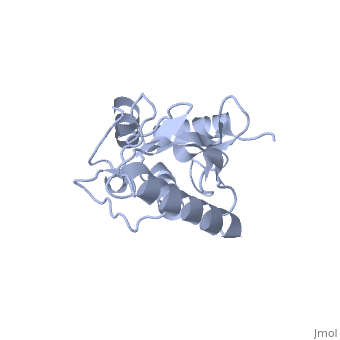Ubc9
From Proteopedia
(Difference between revisions)
| Line 12: | Line 12: | ||
== Function == | == Function == | ||
| - | ''Ubc9'' is enzymatically involved in the SUMOylation process, as it is responsible for ligating the SUMO to the protein. If the reaction occurs ''in vitro'', Ubc9 will ligate the SUMO directly to the substrate, while if the reaction occurs ''in vivo'', the SUMO will be ligated to the conjugating enzyme (E3) and then ligated onto the substrate <ref name="protein control">PMID:25097219</ref>. Initially in the SUMOylation pathway, a thioester bond is formed between the SUMO and the E1 enzyme via an ATP-dependent reaction. Next, the SUMO is transferred to the active cysteine of the E2, in this case, Ubc9. Finally, the SUMO is ligated to a lysine side chain amino group of the substrate, during which an E3 enzyme may or may not be recruited. The use of E3 mediated transfer serves functions such as increasing the specificity for the substrate to be SUMOylated <ref name="ubcsumocomplex"/>. Ubc9 has been found to be predominantly nuclear, with its N-terminal amino acids being integral to its localization. Ubc9 nuclear accumulation is vital for normal SUMOylation rates <ref name="n terminal amino acids"/>. | + | ''Ubc9'' is enzymatically involved in the SUMOylation process, as it is responsible for ligating the SUMO to the protein. If the reaction occurs ''in vitro'', Ubc9 will ligate the SUMO directly to the substrate, while if the reaction occurs ''in vivo'', the SUMO will be ligated to the conjugating enzyme (E3) and then ligated onto the substrate <ref name="protein control">PMID:25097219</ref>. Initially in the SUMOylation pathway, a thioester bond is formed between the SUMO and the E1 enzyme via an ATP-dependent reaction. Next, the SUMO is transferred to the active cysteine of the E2, in this case, Ubc9. Finally, the SUMO is ligated to a lysine side chain amino group of the substrate, during which an E3 enzyme may or may not be recruited. The use of E3 mediated transfer serves functions such as increasing the specificity for the substrate to be SUMOylated <ref name="ubcsumocomplex"/>. |
| + | |||
| + | Ubc9 has been found to be predominantly nuclear, with its N-terminal amino acids being integral to its localization. Ubc9 nuclear accumulation is vital for normal SUMOylation rates <ref name="n terminal amino acids"/>. | ||
Kinetic analysis has shown that the Ubc9 amino acids <scene name='69/694804/Cys93lys101asp100/2'>Asp100 and Lys101</scene>, which are in close proximity to the active site Cys93, play a role in substrate recongnition within the thioester Ubc9-SUMO1 complex. These amino acids are not found in other E2 enzymes, making their involvement in SUMO conjugation unique to Ubc9 <ref name="asp100lys101">PMID:12641448</ref>. | Kinetic analysis has shown that the Ubc9 amino acids <scene name='69/694804/Cys93lys101asp100/2'>Asp100 and Lys101</scene>, which are in close proximity to the active site Cys93, play a role in substrate recongnition within the thioester Ubc9-SUMO1 complex. These amino acids are not found in other E2 enzymes, making their involvement in SUMO conjugation unique to Ubc9 <ref name="asp100lys101">PMID:12641448</ref>. | ||
Revision as of 01:31, 26 February 2015
| |||||||||||
References
- ↑ 1.0 1.1 Tong H, Hateboer G, Perrakis A, Bernards R, Sixma TK. Crystal structure of murine/human Ubc9 provides insight into the variability of the ubiquitin-conjugating system. J Biol Chem. 1997 Aug 22;272(34):21381-7. PMID:9261152
- ↑ 2.0 2.1 Sekhri P, Tao T, Kaplan F, Zhang XD. Characterization of amino acid residues within the N-terminal region of Ubc9 that play a role in Ubc9 nuclear localization. Biochem Biophys Res Commun. 2015 Feb 27;458(1):128-33. doi:, 10.1016/j.bbrc.2015.01.081. Epub 2015 Jan 27. PMID:25637535 doi:http://dx.doi.org/10.1016/j.bbrc.2015.01.081
- ↑ Yunus AA, Lima CD. Lysine activation and functional analysis of E2-mediated conjugation in the SUMO pathway. Nat Struct Mol Biol. 2006 Jun;13(6):491-9. Epub 2006 May 28. PMID:16732283 doi:http://dx.doi.org/10.1038/nsmb1104
- ↑ Reverter D, Lima CD. Insights into E3 ligase activity revealed by a SUMO-RanGAP1-Ubc9-Nup358 complex. Nature. 2005 Jun 2;435(7042):687-92. PMID:15931224 doi:10.1038/nature03588
- ↑ 5.0 5.1 5.2 5.3 Knipscheer P, van Dijk WJ, Olsen JV, Mann M, Sixma TK. Noncovalent interaction between Ubc9 and SUMO promotes SUMO chain formation. EMBO J. 2007 Jun 6;26(11):2797-807. Epub 2007 May 10. PMID:17491593
- ↑ Gupta MK, Gulick J, Liu R, Wang X, Molkentin JD, Robbins J. Sumo E2 enzyme UBC9 is required for efficient protein quality control in cardiomyocytes. Circ Res. 2014 Sep 26;115(8):721-9. doi: 10.1161/CIRCRESAHA.115.304760. Epub 2014, Aug 5. PMID:25097219 doi:http://dx.doi.org/10.1161/CIRCRESAHA.115.304760
- ↑ Tatham MH, Chen Y, Hay RT. Role of two residues proximal to the active site of Ubc9 in substrate recognition by the Ubc9.SUMO-1 thiolester complex. Biochemistry. 2003 Mar 25;42(11):3168-79. PMID:12641448 doi:http://dx.doi.org/10.1021/bi026861x
- ↑ Lee B, Muller MT. SUMOylation enhances DNA methyltransferase 1 activity. Biochem J. 2009 Jul 15;421(3):449-61. doi: 10.1042/BJ20090142. PMID:19450230 doi:http://dx.doi.org/10.1042/BJ20090142
- ↑ Kulinski A, Rustaeus S, Vance JE. Microsomal triacylglycerol transfer protein is required for lumenal accretion of triacylglycerol not associated with ApoB, as well as for ApoB lipidation. J Biol Chem. 2002 Aug 30;277(35):31516-25. Epub 2002 Jun 18. PMID:12072432 doi:http://dx.doi.org/10.1074/jbc.M202015200
- ↑ Tatham MH, Kim S, Yu B, Jaffray E, Song J, Zheng J, Rodriguez MS, Hay RT, Chen Y. Role of an N-terminal site of Ubc9 in SUMO-1, -2, and -3 binding and conjugation. Biochemistry. 2003 Aug 26;42(33):9959-69. PMID:12924945 doi:http://dx.doi.org/10.1021/bi0345283
- ↑ Kumar A, Ito A, Hirohama M, Yoshida M, Zhang KY. Identification of sumoylation inhibitors targeting a predicted pocket in Ubc9. J Chem Inf Model. 2014 Oct 27;54(10):2784-93. doi: 10.1021/ci5004015. Epub 2014, Sep 18. PMID:25191977 doi:http://dx.doi.org/10.1021/ci5004015
- ↑ Mo YY, Moschos SJ. Targeting Ubc9 for cancer therapy. Expert Opin Ther Targets. 2005 Dec;9(6):1203-16. PMID:16300471 doi:http://dx.doi.org/10.1517/14728222.9.6.1203
- ↑ Li H, Niu H, Peng Y, Wang J, He P. Ubc9 promotes invasion and metastasis of lung cancer cells. Oncol Rep. 2013 Apr;29(4):1588-94. doi: 10.3892/or.2013.2268. Epub 2013 Feb 1. PMID:23381475 doi:http://dx.doi.org/10.3892/or.2013.2268

